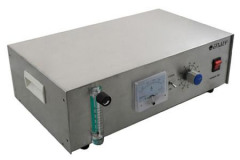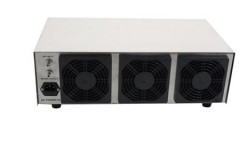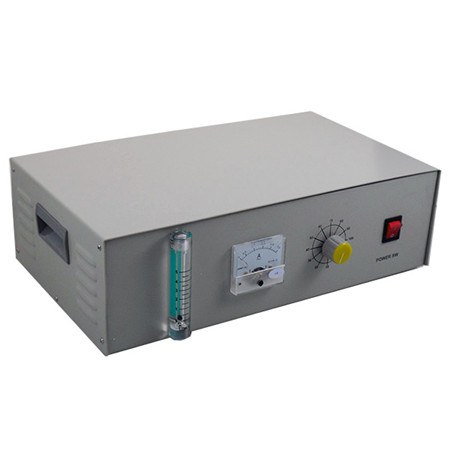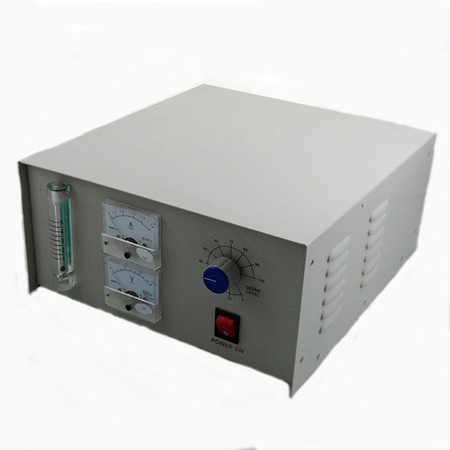Our highly efficient Air-cooled commercial ozone machine can run for an extensive period of time without decreasing ozone output. These generators are being used for drinking water treatment; industrial and municipal wastewater treatments; odor control; air purification; agricultural, food processing, aquaculture, and marine uses.
This ozone generator uses the most advanced Corona Discharge Technology to generate ozone. The ozone cell is carefully designed and constructed with high quality materials for reliable and efficient operation.
Each unit is inspected and tested rigorously before sending over to the customer. Our strict and comprehensive inspecting and testing procedures will ensure that every unit performs according to their specifications and offers a long life service to any demanding application.
Specifications of 5000BF Commercial Ozone Machine:
Model Name: 5000BF
Case size: 442mmX310mmX148mm
Input Power: AC110V / AC220V
Ozone Output: See chart
Cooling Method: Air cooling only
Feed Gas: Oxygen or Ambient air
Ozone Generating Method: Corona Discharge (Ozone Tube)
Wattage:100W
Weight: 8 kg
Max. Ozone Outputs by Dry Clean Air
| Air flow (L/min) | Ozone output (mg/H) |
|---|---|
| 2 | 700 |
| 4 | 1000 |
| 5 | 900 |
Max. Ozone Outputs by Pure Oxygen
| Oxygen flow (L/min) | Ozone output (mg/H) |
|---|---|
| 2 | 3000 |
| 2.5 | 4200 |
| 3 | 5000 |
Features of 5000BF Commercial Ozone Machine:
1. Low power consumption with high ozone output.
2. Air cooling only. No needs of cooling water system
3. Integrated designs.
4. Long life performance.
5. Low prices. Low running costs.
Application Cases for Commercial Ozone Machines in Technical Labs
1. Laboratory Air Purification:
– Odor Control: Eliminate chemical fumes and unpleasant odors from the lab environment, ensuring a more pleasant workspace.
– Pathogen Reduction: Purify the air by reducing airborne bacteria and viruses, promoting a safer working environment.
2. Equipment Sterilization:
– Disinfecting Lab Instruments: Use ozone to sterilize reusable lab equipment and instruments, reducing contamination risks.
– Cleaning Glassware: Ozone can effectively remove residues and contaminants from glassware used in experiments.
3. Water Treatment:
– Purifying Laboratory Water Supplies: Treat water used in experiments to eliminate microorganisms and ensure consistent quality.
– Pre-treatment for Experiments: Use ozone to remove organic compounds from water before it is used in sensitive experiments.
4. Sample Preservation:
– Extending Shelf Life: Preserve biological samples and reagents by reducing microbial growth and contamination during storage.
– Sterilizing Storage Areas: Ozone can be used to disinfect storage cabinets and areas where samples are kept.
5. Chemical Waste Management:
– Decomposing Hazardous Chemicals: Utilize ozone to oxidize and decompose hazardous chemical waste, making disposal safer and more manageable.
– Odor Neutralization: Control odors emitted from waste containers or storage areas for chemical waste.
6. Surface Disinfection:
– Sanitizing Workstations: Regularly disinfect lab benches and work surfaces to prevent cross-contamination between experiments.
– Cleaning High-Touch Areas: Target frequently touched surfaces, such as doorknobs and equipment controls, to minimize contamination risk.
7. Research and Development:
– Studying Ozone Effects: Use ozone in experiments related to environmental science, materials testing, or microbiology to assess its impacts and efficacy.
– Material Testing: Evaluate the effects of ozone on various materials and substances for research purposes.
8. Biosafety Applications:
– Decontaminating Biosafety Cabinets: Use ozone to disinfect biosafety cabinets and ensure a sterile environment for sensitive work.
– Laboratory Containment Areas: Sanitize containment areas for biological samples or hazardous materials.
9. Aquaculture and Biological Research:
– Water Quality Management: Maintain optimal water quality in aquaculture studies by reducing pathogens and organic load.
– Supporting Aquatic Research: Use ozone for experiments involving aquatic organisms to ensure a clean and healthy environment.
10. Fume Hood Cleaning:
– Deodorizing and Disinfecting Fume Hoods: Regularly treat fume hoods to prevent buildup of odors and contaminants from chemical use.
Images of 5000BF:




